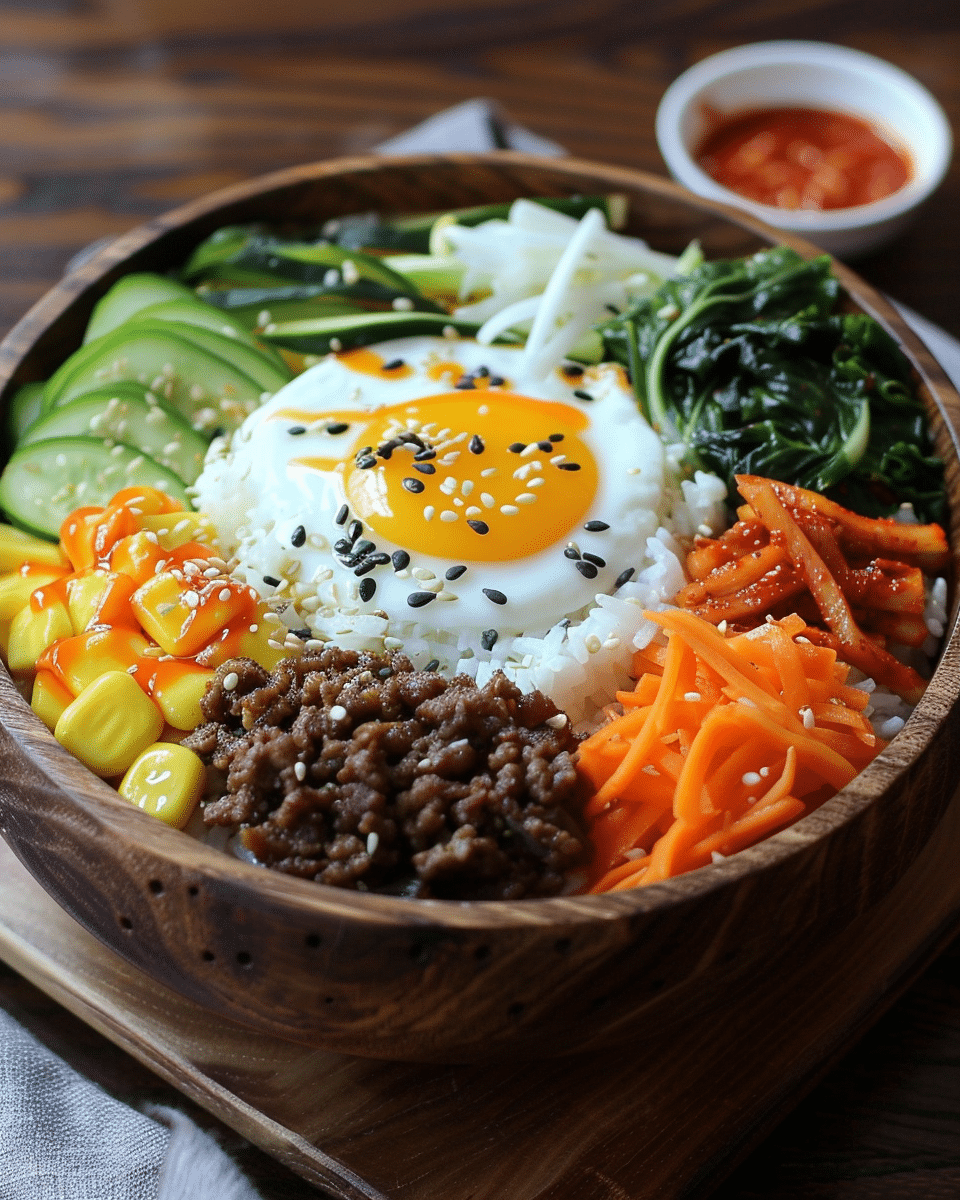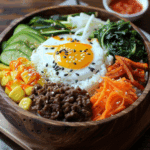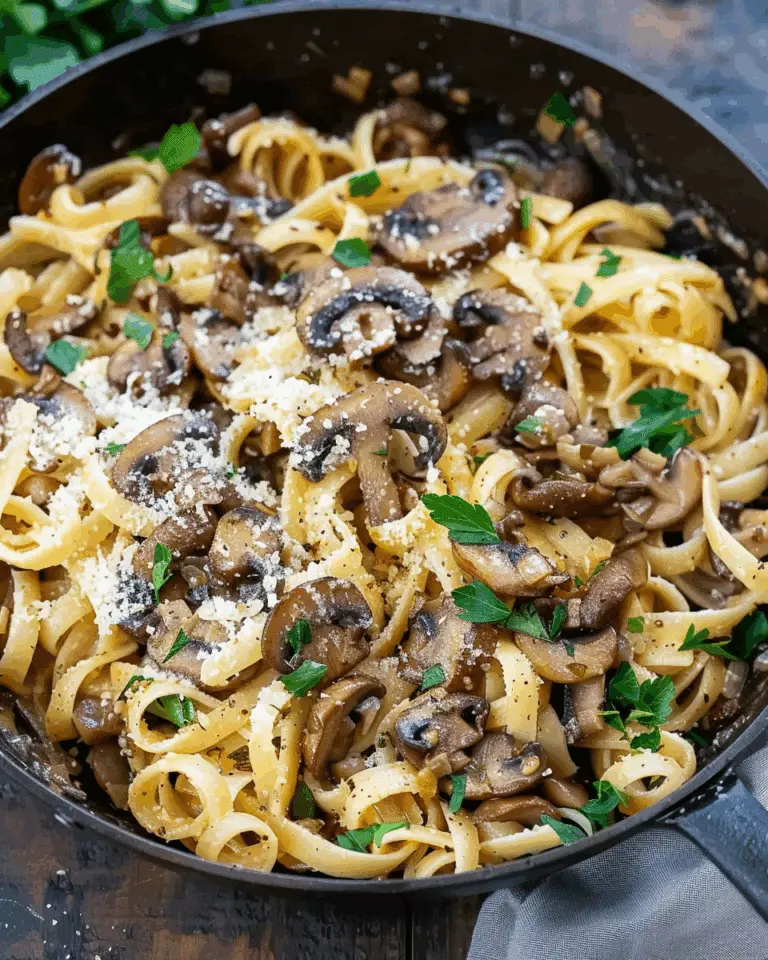Bibimbap, a delicious Korean dish, combines seasoned vegetables, protein, and rice, all topped with a fried egg and a spicy-sweet gochujang sauce. This dish is as flavorful as it is visually stunning, offering a healthy and balanced meal in one bowl. Whether you prefer beef, tofu, or just the vegetables, bibimbap is a versatile and satisfying dish for any occasion.

Why You’ll Love This Recipe
Bibimbap is a one-bowl meal that brings together a harmonious blend of flavors and textures. From the tender rice and sautéed vegetables to the savory protein and creamy fried egg, this dish is both nutritious and comforting. The gochujang sauce adds a perfect spicy-sweet kick, elevating the overall flavor. It’s a customizable dish, so you can adjust the ingredients and toppings to suit your preferences. Plus, it’s quick to prepare and perfect for a satisfying dinner or lunch.
Ingredients
For the rice:
2 cups cooked short-grain white rice (or sushi rice)
For the vegetables (choose your favorites):
1 cup spinach, blanched and squeezed dry
1 medium carrot, julienned and sautéed
1 cup bean sprouts, blanched
4 shiitake mushrooms, sliced and sautéed
1 zucchini, julienned and sautéed
1 small cucumber, thinly sliced (optional)
2 eggs (fried or sunny-side up)
For the protein (optional):
200 g ground beef or sliced beef, marinated in 1 tbsp soy sauce, 1 tsp sugar, 1 clove garlic minced, and 1 tsp sesame oil
Or tofu, grilled or pan-fried
For the sauce (gochujang sauce):
3 tbsp gochujang (Korean chili paste)
1 tbsp sesame oil
1 tbsp sugar or honey
1 tbsp water
1 tsp rice vinegar or lemon juice
1 tsp toasted sesame seeds
(Tip: You’ll find the full list of ingredients and measurements in the recipe card below.)
Directions
-
Prepare vegetables: Sauté each vegetable separately in a little oil and season lightly with salt. Set aside.
-
Cook protein: If using beef, cook it in a pan over medium heat until browned and cooked through. If using tofu, pan-fry until golden.
-
Make sauce: Whisk all sauce ingredients together until smooth.
-
Assemble bowls: Place warm rice in bowls. Arrange vegetables and protein neatly on top.
-
Add egg: Top each bowl with a fried egg.
-
Serve: Drizzle gochujang sauce over everything. Mix thoroughly before eating!
Servings and Timing
-
Servings: 2–3
-
Prep & Cook Time: 40 minutes
Variations
-
Vegetarian/Vegan: Omit the beef and egg for a fully plant-based version. You can add more tofu or even tempeh for added protein.
-
Spicy: Increase the amount of gochujang or add a few chili flakes to the sauce for an extra spicy kick.
-
Add-ins: For added flavor, consider adding kimchi, pickled radish, or seaweed flakes.
Storage/Reheating
-
Storage: You can store leftover bibimbap in an airtight container in the fridge for up to 2 days. Keep the gochujang sauce separate to avoid sogginess.
-
Reheating: To reheat, microwave the rice and vegetables. If you want to recreate the crispy rice, you can heat the rice in a pan with a little oil until it crisps up. Add a freshly fried egg before serving if desired.
FAQs
1. Can I use brown rice instead of white rice for bibimbap?
Yes, brown rice is a healthier alternative, but it may have a different texture and take longer to cook.
2. Is bibimbap served hot or cold?
Bibimbap is typically served warm, with the rice slightly steaming and the vegetables and protein at room temperature or heated.
3. Can I make bibimbap in advance?
You can prep the ingredients in advance and assemble the bibimbap just before serving for the best results.
4. What is gochujang, and where can I find it?
Gochujang is a Korean chili paste made from fermented soybeans, chili powder, and rice. It’s commonly found in Asian grocery stores or online.
5. Can I use any vegetables for bibimbap?
Yes, feel free to use your favorite vegetables. Traditional options include spinach, carrots, bean sprouts, mushrooms, and zucchini.
6. Can I use a different protein in place of beef?
Absolutely! You can use chicken, pork, tofu, or even seafood for a different protein option.
7. How can I adjust the spice level in the gochujang sauce?
To adjust the spice level, simply add more or less gochujang, or balance it with more honey or sugar if you prefer a sweeter taste.
8. Can I make bibimbap without the fried egg?
Yes, if you prefer, you can skip the fried egg or use a boiled egg instead.
9. Is there a gluten-free version of bibimbap?
Yes, to make a gluten-free bibimbap, use tamari (gluten-free soy sauce) and check that the gochujang is gluten-free.
10. Can I serve bibimbap in a stone bowl?
Yes, using a dolsot (stone bowl) will give you the traditional crispy rice at the bottom, adding texture and flavor.
Conclusion
Bibimbap is a wonderfully customizable and satisfying meal that’s packed with flavor, texture, and nutrition. Whether you’re a meat lover, a vegetarian, or someone looking for a hearty yet light dish, this Korean classic has something for everyone. With its easy-to-prepare ingredients and deliciously spicy-sweet gochujang sauce, bibimbap will quickly become a favorite in your recipe rotation.

Bibimbap (Korean Mixed Rice & Vegetables)
5 Stars 4 Stars 3 Stars 2 Stars 1 Star
No reviews
- Author: Olivia
- Total Time: 40 minutes
- Yield: 2-3 servings
Description
Bibimbap (Korean Mixed Rice & Vegetables) is a flavorful and nutritious Korean dish made with warm rice, sautéed vegetables, protein of choice, and topped with a fried egg and spicy-sweet gochujang sauce. It’s a customizable, one-bowl meal that’s quick to prepare and full of satisfying flavors.
Ingredients
For the rice:
2 cups cooked short-grain white rice (or sushi rice)
For the vegetables (choose your favorites):
1 cup spinach, blanched and squeezed dry
1 medium carrot, julienned and sautéed
1 cup bean sprouts, blanched
4 shiitake mushrooms, sliced and sautéed
1 zucchini, julienned and sautéed
1 small cucumber, thinly sliced (optional)
2 eggs (fried or sunny-side up)
For the protein (optional):
200 g ground beef or sliced beef, marinated in 1 tbsp soy sauce, 1 tsp sugar, 1 clove garlic minced, and 1 tsp sesame oil
Or tofu, grilled or pan-fried
For the sauce (gochujang sauce):
3 tbsp gochujang (Korean chili paste)
1 tbsp sesame oil
1 tbsp sugar or honey
1 tbsp water
1 tsp rice vinegar or lemon juice
1 tsp toasted sesame seeds
Instructions
- Prepare vegetables: Sauté each vegetable separately in a little oil and season lightly with salt. Set aside.
- Cook protein: If using beef, cook it in a pan over medium heat until browned and cooked through. If using tofu, pan-fry until golden.
- Make sauce: Whisk all sauce ingredients together until smooth.
- Assemble bowls: Place warm rice in bowls. Arrange vegetables and protein neatly on top.
- Add egg: Top each bowl with a fried egg.
- Serve: Drizzle gochujang sauce over everything. Mix thoroughly before eating!
Notes
- Vegetarian/Vegan: Omit the beef and egg for a plant-based version. Add more tofu or tempeh for extra protein.
- Spicy: Add more gochujang or chili flakes to the sauce for an extra spicy kick.
- Add-ins: Consider adding kimchi, pickled radish, or seaweed flakes for extra flavor.
- Storage: Store leftovers in an airtight container for up to 2 days. Keep the gochujang sauce separate to avoid sogginess.
- Prep Time: 10 minutes
- Cook Time: 30 minutes
- Category: Main Dish
- Method: Stir-fry
- Cuisine: Korean
Nutrition
- Serving Size: 1 serving
- Calories: 450
- Sugar: 8g
- Sodium: 800mg
- Fat: 18g
- Saturated Fat: 3g
- Unsaturated Fat: 12g
- Trans Fat: 0g
- Carbohydrates: 50g
- Fiber: 4g
- Protein: 20g
- Cholesterol: 180mg






